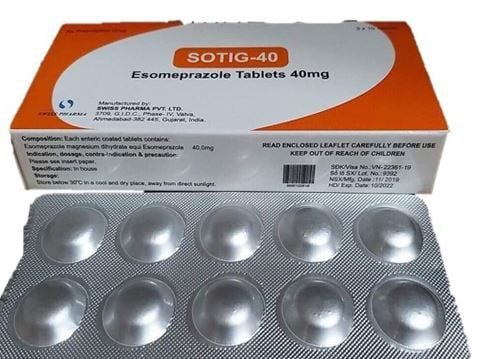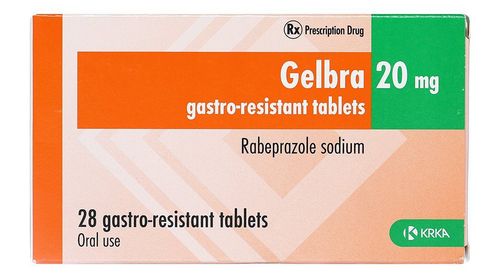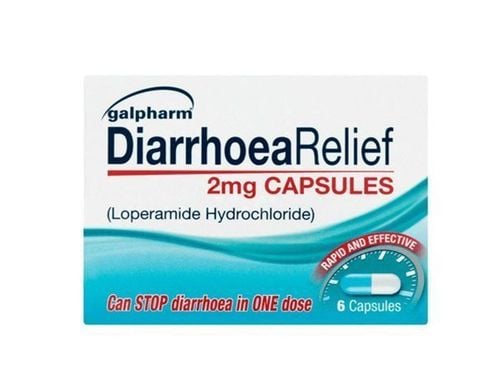This is an automatically translated article.
Prazopro 20mg medicine contains the main ingredient is Esomeprazole. This medicine is used to treat stomach ulcers, duodenal ulcers, gastroesophageal reflux disease, esophagitis, Zollinger–Ellison syndrome, bleeding due to severe gastric and duodenal ulcers. In addition, the drug is also used in the prevention and treatment of gastric and duodenal ulcers caused by the use of non-steroidal anti-inflammatory drugs and by stress.
1. Find out the use and effectiveness of the drug Prazopro 20mg
1.1 Pharmacodynamics of Prazopro 20mg Esomeprazole component in Prazopro is the S-isomer of omeprazole, which can be used similarly to omeprazole in the treatment of gastric ulcer, duodenal ulcer, gastroesophageal reflux disease, oesophagitis and peptic ulcer disease. Zollinger–Ellison syndrome. Esomeprazole binds to H+/K+-ATPase (proton pump) present in parietal cells of the stomach and has a specific mechanism of action that inhibits this enzyme system, preventing the secretion of acid hydrochloride into the gastric lumen. Therefore, esomeprazole provides an inhibitory effect on gastric acid secretion both basal and even when stimulated by any agent. Prazopro has a strong and long-lasting effect.
For proton pump inhibitors, they only inhibit but cannot eradicate Helicobacter pylori. Therefore, they need to be combined with antibiotics such as Amoxicillin, Tetracycline and Clarithromycin to be able to effectively eliminate this bacteria.
1.2 Pharmacokinetics of the drug Prazopro 20mg The body is able to absorb Esomeprazole quickly, from 1-2 hours after oral administration, peak concentrations will be reached. Absolute bioavailability increases with increasing dose. When 20 mg is taken, the bioavailability is about 50%, and when the dose is doubled to 40 mg, the bioavailability increases to about 68%.
Food will slow down and reduce the absorption of Esomeprazole, but will not change the effect of the drug on the acidity in the stomach. If the drug is taken with a meal, the area under the curve (AUC) after a single dose of 40 mg will be reduced by 33–53% compared with taking the same amount in the fasted state. Therefore, the drug should be taken at least 1 hour before meals.
Approximately 97% of Esomeprazole is bound to plasma proteins, the volume of distribution in healthy subjects at steady-state concentrations is about 0.22L/kg.
The liver is the main site of metabolism of the drug, thanks to the isoenzyme CYP2C19, the cytochrome P450 enzyme system. They are converted to inactive hydroxy and desmethyl metabolites. The remainder will be converted to esomeprazole sulfone by isoenzyme CYP3A4.
On repeated administration, because the CYP2C19 isoenzyme is inhibited, hepatic metabolism and clearance are reduced. The drug does not tend to accumulate if taken only once daily. In the event that some people are genetically deficient in CYP2C19 (approximately 15–20% of Asians) the metabolism of Esomeprazole will slow down, resulting in an increase in AUC approximately 2 times higher than in individuals with sufficient enzyme.
The half-life will be between 1 and 1.5 hours. Approximately 80% of the ingested drug is eliminated as inactive metabolites in the urine, the remainder in the feces. In patients with severe hepatic impairment, the stable AUC value is 2 to 3 times higher than in normal subjects, so the dose should be reduced in these patients.
2. Dosage and usage of Prazopro
Prazopro is a hard capsule that needs to be swallowed with water, not chewed or crushed.
2.1 Dosage for adults and children over 12 years of age For the treatment of gastric and duodenal ulcers caused by Helicobacter pylori infection:
Esomeprazole is present in the drug, which is often prescribed together with antibiotics. In the case of regimen 3, Prazopro will be combined with Amoxicillin and Clarithromycin. In regimen 4, Prazopro will be combined with Clarithromycin, Metronidazole and Bismuth. Depending on the rate of drug resistance in each person, the doctor will advise the appropriate regimen. Dosage of Prazopro will be as follows: 1 tablet (20 mg) each time, 2 times a day and drink within 7 days. For the treatment of gastric ulcers caused by non-steroidal anti-inflammatory drugs or stress: 1 tablet (20 mg) daily, taken for 4 to 8 weeks.
For peptic ulcer disease in people who are at high risk of complications in the stomach and duodenum but still need to continue treatment with non-steroidal anti-inflammatory drugs: 1 tablet (20 mg) per day.
For the treatment of gastroesophageal reflux disease, severe esophagitis with esophagitis:
1 tablet (20 mg) daily, taken for 4 to 8 weeks. In case the lesion has not healed, continue to drink for another 4 - 8 weeks. For maintenance treatment after recovering from esophagitis: Take 1 tablet (20 mg) daily.
For treatment of Zollinger–Ellison syndrome:
Depending on the degree of increased acid secretion of gastric juice, the dose varies. , can be used once or divided into 2 times a day; At first, take 2 tablets twice a day, each time (40mg), then adjust the dose in case of need. Most of the time, when taking a dose of 4-8 tablets (80-160 mg) per day, the disease can be controlled. For oral doses of more than 4 tablets per day, it must be divided into 2 doses. 2.2 Dosage for other subjects For people with mild and moderate liver failure, drink as normal people. And people with severe liver failure should not take more than 1 tablet (20mg) per day; For people with kidney failure: The dose is equivalent to people with liver failure; No dose reduction is necessary for the elderly; Not recommended for use in children under 12 years of age. Note: The above doses are for reference only, the effectiveness of the drug will depend on the user's condition and disease level. For appropriate dosage and treatment regimen, patients should consult their doctor or healthcare professional.
3. The side effects of the drug Prazopro 20mg
Common side effects
Headache, dizziness; Skin rash; Effects on the digestive system such as nausea, vomiting, abdominal pain, diarrhea, constipation, flatulence, dry mouth. Uncommon side effects
Fatigue, insomnia, drowsiness; Rash, itching; Visual disturbances. Rare side effects:
High fever, sweating, peripheral edema, photosensitivity, urticaria, angioedema, bronchospasm, anaphylaxis...; Becoming agitated, depressed, reversible confusion, hallucinations in critically ill patients; Agranulocytosis, leukopenia, thrombocytopenia; Increased liver enzymes, hepatitis, impaired liver function; Taste disorder, stomatitis, interstitial nephritis; Hypomagnesaemia, blood sodium, porphyrin metabolism disorders; Musculoskeletal pain; Occurrence of gynecomastia in men. Bullous rash, Stevens–Johnson syndrome, toxic epidermal necrolysis, dermatitis. Due to decreased acidity in the stomach, proton pump inhibitors may increase the risk of bacterial infections in the gastrointestinal tract. In case of experiencing side effects, users should temporarily stop taking the drug and contact a doctor immediately.
4. Potential interactions with other drugs
For drugs whose absorption mechanism depends on gastric acidity, the use of Prazopro may increase or decrease the absorption of these drugs. For example, Ketoconazole and Itraconazole may be reduced when treated with Esomeprazole. Drugs metabolized by CYP2C19 such as Diazepam, Citalopram, .... plasma concentrations may be increased when co-administered with Esomeprazole. Therefore, it is necessary to reduce the dose of these drugs. When taking three drugs simultaneously: Esomeprazole, Amoxicillin, Clarithromycin will increase the concentration of Esomeprazole and 14 hydroxy clarithromycin in the blood.5. Preservation of Prazopro
The medicine should be stored in a dry place, away from direct sunlight and with an ideal temperature below 30oC. Make sure the medicine is kept out of reach of children.
Prazopro 20mg medicine contains the main ingredient is Esomeprazole. This medicine is used to treat gastric and duodenal ulcers, gastroesophageal reflux disease, esophagitis, Zollinger–Ellison syndrome, bleeding due to severe gastric and duodenal ulcers. Because the drug can cause unwanted side effects, the patient should strictly follow the instructions of the doctor.
Follow Vinmec International General Hospital website to get more health, nutrition and beauty information to protect the health of yourself and your loved ones in your family.
Please dial HOTLINE for more information or register for an appointment HERE. Download MyVinmec app to make appointments faster and to manage your bookings easily.













